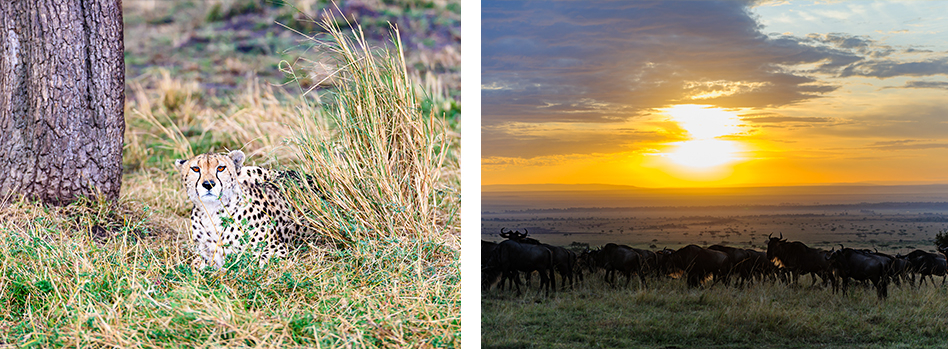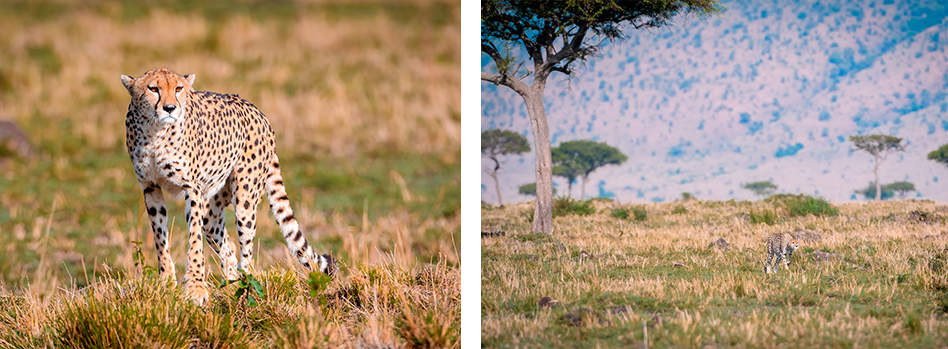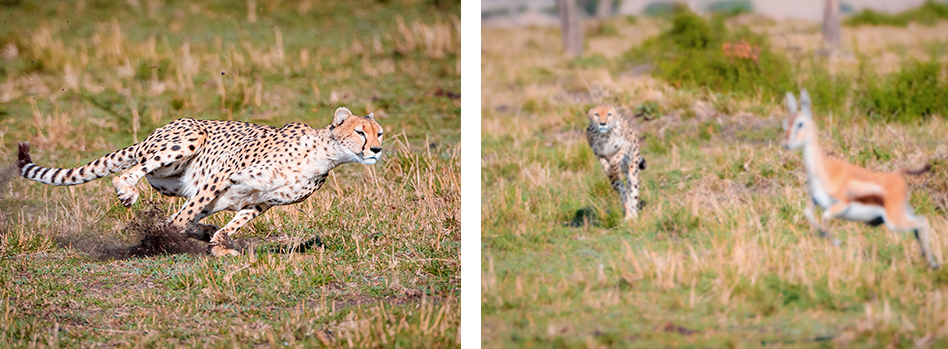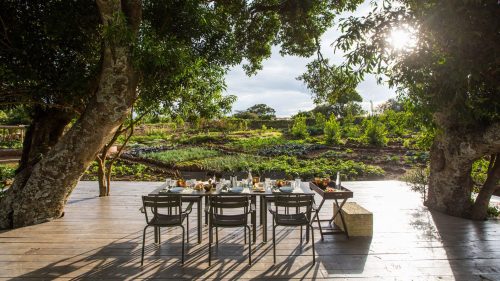
My stay at Angama in October 2018 was a bit of an oddity. I didn’t intend for it to be a migration safari. They simply weren’t supposed to be there. By all accounts, the bulk of the herd should have been well into Tanzania by then. But wildebeest have their own schedule, and they decided to arrive fashionably late in Kenya.
As the plane from Wilson descended into the Mara Triangle, they looked like thousands of ants stretching all the way to the horizon. On previous trips, I’d seen a river crossing or two, but I’d never been in the Mara at the absolute peak of the migration. We were treated to daily river crossings of thousands of animals. It was an epic experience. As incredible as the migration was, though, it was a sighting on my final morning, that would be the highlight of my trip.

At university, working at the student newspaper, I photographed whatever I was assigned, but quickly gravitated towards sports photography. I went to a big American university, with a prominent athletics programme and I was never short on high-quality sporting events to cover. Sports photography requires a specific skill set, and for years after I graduated, I struggled to find a subject that utilised those skills. That all changed when I went on my first safari. Wildlife photography is like sports photography, but with a much bigger playing field and no rules.
Straight away, I developed an affinity for big cats, but soon discovered that photographing different species presents different challenges. Lions are social cats, and the interactions between them often provide fantastic photographic opportunities. However, the solitary nature of leopards and cheetahs makes freezing emotive moments difficult, as they are not interacting with other animals very often. The image that I wanted to capture was of a cheetah running full speed, totally focused, looking right at the camera. I wanted to capture the focus and intensity.
I had seen a few cheetah hunts on previous trips, but we usually got there too late, or were too far away. Something I learned over the course of those sightings was that most important element for successfully photographing a hunt is the prey animal. If you know what is being hunted, you can position yourself accordingly. For leopards, there is seldom much of a chase as they are ambush hunters. Unless you’ve gotten into position while the leopard is stalking, you’re usually out of luck. Lion adapt their hunting style to their quarry, and you’ll see different methods whether they’re going after buffalo, zebra, wildebeest or warthog. Cheetah are a particular challenge because they’re moving so quickly, that unless you know what they are going after, it’s impossible to predict which way they’re going to go. On top of that, once they’re past you, you’re definitely not catching up.

On my final afternoon safari, we came across a lone female cheetah. She was huddled under a tree, attempting to relax, but constantly checking the horizon for other predators. My guide, John, said that she didn’t look like she was going to hunt that day as the sun was going down and storm clouds were approaching. We left her and headed back to camp, barely beating the rain.
The following morning, we were first through the gate at the top of the escarpment, where we were greeted by a herd of wildebeest and a proper Mara sunrise. We headed straight back to where we’d left the cheetah the previous evening. After an hour of looking, John found her resting on a small mound, looking much more at ease than she did the previous afternoon. We settled down and enjoyed the privilege of being so close to such a beautiful animal with no other vehicles around. While I took some portraits, John began scanning with his binoculars, looking for her potential breakfast. While we were sitting, John and I remarked that we’d only really seen one or two Thomson’s gazelle on the way in.

About 30 minutes later, the cheetah rose up on her front legs and started looking into the distance, before leisurely walking in the direction we’d came from. We knew there was only one possible target for her. John started the engine and drove about 200 meters back from where we’d come, getting ahead of the cheetah. We looked back. She had stopped, clearly fixated on something. It had been 10 minutes since she’d gotten up. We looked to where she was looking and saw the lone gazelle we’d driven past earlier that morning. Looking back to the cheetah, she had gotten into the unmistakable crouch of a big cat stalking its prey. John started driving forward with some urgency. We drove beyond the gazelle and hooked back around, so that gazelle was roughly halfway along a straight line between us and the cheetah. In theory, if she gave chase, the gazelle would run right towards us, with the cheetah in hot pursuit. We waited.

Five minutes later, the cheetah burst out from behind a bush at full speed. The gazelle had been facing perpendicular to where the cheetah was coming from but was at a huge disadvantage being on its own. Thomson’s gazelle usually live in herds, and many hunts are ruined when they scatter and the predator momentarily loses focus. There was no such diversion here.

The gazelle initially ran towards us, before turning tightly, trying to shake the cheetah. Left, then right, then left again, but the cheetah was locked on. As the cheetah closed in, she began flicking at the hind legs of the gazelle, trying to trip it. She flicked once, but the Tommy kept its feet. She flicked again, no luck. Finally, on the fourth flick, the gazelle fell.

From the instant the cheetah took off running, to the gazelle going down, was roughly 30 seconds. It took a few minutes for my heart rate to come back down to normal. As I scrolled through the shots on the back of my camera, I stopped on one image. There it was. The one I had been imagining since I’d first touched down for my first safari years earlier.
Filed under: The Mara
Subscribe for Weekly Stories
Comments (3):
7 April 2020
It also shows how much patience is required to get a photo like this - half an hour just watching the cheetah . Plus an understanding of her behaviour and what she was most likely to hunt, and positioning yourself accordingly. All this takes years of bush experience... It is a wonderful photograph and story... Thank you.
7 April 2020
Great picture - thanks for sharing the build up!

The Angama Shamba